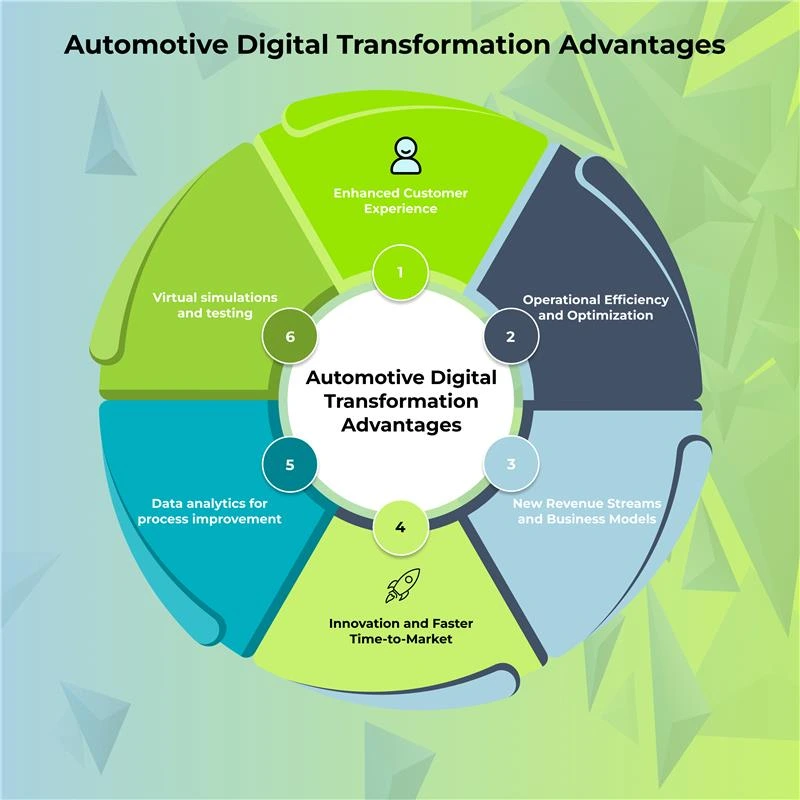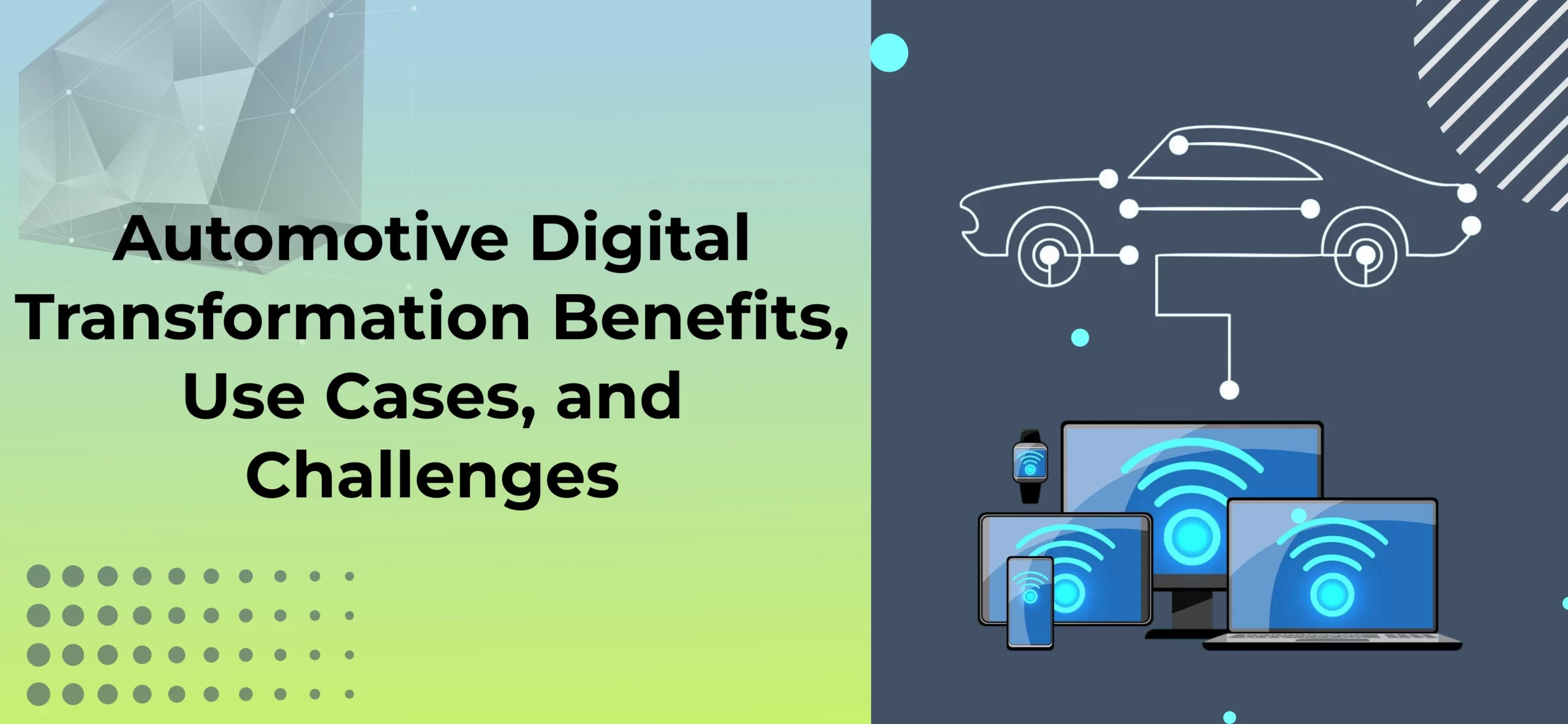Think of a world where your car anticipates your needs, updates software overnight, improves performance, and intelligently navigates traffic. This isn’t science fiction–it’s the digital transformation of automobiles. By 2030, over 70% of new cars will be sold globally as connected cars. With the integration of IoT technology, this will pave the way for unprecedented and advanced solutions.
So, what does the phrase “digital transformation of the automobile industry” reframe within the sector? It is not as easy as mounting screens and adding connectivity features. It pertains to integrating computing technologies within the automotive value chain, starting from designing and manufacturing the vehicles, which doesn’t include selling, servicing, or even using the car. Forget about “in the future” proclamations; this radical change is already occurring. This shift is propelling the industry and determining who will thrive and struggle. In this blog post, we examine the benefits and diverse use cases.
Understanding Digital Transformation in the Automotive Industry
The automotive industry is going through a profound transformation– automotive digital transformation is more than simply implementing new technology. This is a change in culture, business strategies, frameworks, and operations. It is about transforming how value is created for consumers, enhancing customer experience, and improving operational efficiency, innovation, and mobility using information systems and data. This represents the integrated application of digital capabilities throughout the entire automotive ecosystem, powered by emerging technologies such as automotive software development and intelligent vehicle systems, dismantling traditional barriers to enable enhanced connectivity and data utilization in every phase of the vehicle’s lifecycle. This is not only about upgrading the technology in automobiles but also about changing the connection paradigm between manufacturers, automobiles, and consumers in a digitally integrated environment.
Benefits of Automotive Digital Transformation

Now, let us analyze the advantages of digital transformation in the automotive industry. Each of the points will be elaborated in paragraph format:
Enhanced Customer Experience
Automotive companies can now create and customize unique customer journeys due to the power of digital transformation. Technology has made seamless interaction possible at every point. This is from online configurators and virtual showrooms to connected cars and proactive service reminder features. With the help of data insights, dealerships, and manufacturers can understand customers better, which helps them anticipate their needs and foster greater loyalty and advocacy.
Operational Efficiency and Optimization
Using digital technologies throughout the automotive value chain results in impressive improvements in operational efficiency. Automation of the production processes, sophisticated supply chain control, and upkeep maintenance forecasting decrease costs, cut downtime, and improve resource allocation. Digital instruments also give employees up-to-date information and collaborative tools, improving streamlined workflows and productivity at large.
New Revenue Streams and Business Models
In the automotive domain, connecting vehicles creates new revenue opportunities, such as subscriptions for navigation, entertainment, and advanced driver-assistance systems (ADAS) features. Digital Transformation has overhauled the vehicle lifecycle as continuous feature improvements, and new services can now be offered through over-the-air ( OTA ) updates. In addition, innovation maps to changes in customer data, which can be used to develop new mobility services and explore other monetization touchpoints.
Innovation and Faster Time-to-Market
Innovation has been drastically improved within the automotive space through modern digital tools and methodologies. Development cycles are reduced thanks to advanced simulation and modeling software, rapid prototyping and virtual testing. Moreover, Collaborative Digital Platforms (CDP) encourage peer-to-peer communication and fruitful knowledge exchange within design, engineering, and manufacturing, marking a shift towards vehicles, tools, and technologies that are quickly accessible to the market.
Data Analytics for Process Improvement
The vast data generated across the automotive ecosystem, from vehicle performance to customer interactions, provide invaluable insights for continuous process improvement. Advanced analytics tools can identify bottlenecks in manufacturing, optimize supply chain logistics, predict maintenance needs, and personalize marketing efforts. By harnessing the power of data, automotive companies can make informed decisions, enhance efficiency, and drive continuous improvement across all aspects of their operations.
Virtual Simulations and Testing
Virtual simulations and testing revolutionize how vehicles and components are designed, developed, and validated. By creating realistic digital environments, engineers can conduct extensive testing under various conditions without physical prototypes. This significantly reduces development costs, shortens lead times, and allows for exploring a wider range of design options and scenarios, ultimately leading to safer, more reliable, and innovative vehicles.
Automotive Digital Transformation Use Cases
- Connected Vehicles: This area harnesses digital technologies to boost vehicles’ functionality, safety, and overall user experience by connecting them to networks.
- Infotainment and Navigation: The digital transformation has completely changed the game for in-car entertainment and navigation systems. With cloud-based platforms, drivers can access real-time traffic updates, dynamic routing, streaming services, personalized content, and smooth integration with smartphones and other devices. Natural language processing makes voice commands a safer and more intuitive way to interact with these systems.
- Vehicle-to-Everything (V2X) Communication: This includes technologies that enable vehicles to communicate with one another (V2V), with infrastructure (V2I), with pedestrians (V2P), and with the broader network (V2N). V2X opens the door to various safety features like collision warnings, cooperative adaptive cruise control, and optimized traffic flow. It also lays the groundwork for smart city integration and more efficient transportation systems.
- Remote Diagnostics and Software Updates: Connected vehicles can be monitored from afar for potential issues, allowing for proactive maintenance alerts and even remote troubleshooting in some cases. Over-the-air (OTA) software updates mean drivers no longer need to make physical trips to dealerships for software enhancements, bug fixes, or even new features throughout the vehicle’s life.
- Advanced Driver-Assistance Systems (ADAS): Digital technologies form the backbone of modern ADAS features such as adaptive cruise control, lane-keeping assist, automatic emergency braking, and blind-spot monitoring. These systems depend on various sensors (cameras, radar, lidar) and advanced algorithms to understand the environment and assist the driver, significantly improving safety and convenience.
- Autonomous Driving: This marks a significant shift in personal transportation to create vehicles that can navigate and operate without human input.
- Sensor technology and data processing: Autonomous vehicles depend on a sophisticated mix of sensors, like high-resolution cameras, radar, and lidar, to get a detailed view of their environment. These sensors generate vast amounts of data that must be processed in real time by robust onboard computing systems, allowing the vehicle to understand its surroundings fully.
- AI and machine learning algorithms: At the heart of autonomous vehicles lies artificial intelligence, especially machine learning, which acts as their “brain.” These algorithms are trained on extensive datasets to spot patterns, anticipate the actions of other road users, plan the best routes, and make quick driving decisions. These algorithms need to learn and improve to ensure safety and reliability continuously.
- Impact on transportation and urban planning: The widespread use of autonomous vehicles could significantly transform transportation and urban planning. This includes smoother traffic flow, fewer accidents, better parking solutions, new mobility services, and a redesign of urban infrastructure to support fleets of autonomous vehicles.
- Smart Manufacturing: The digital transformation is shaking up automotive production, leading to more efficient, flexible, and high-quality manufacturing processes.
- Robotics and automation in assembly lines: Cutting-edge robots, often powered by AI and equipped with computer vision, are taking on increasingly complex tasks on assembly lines with more precision and speed than traditional methods. Collaborative robots, or cobots, work alongside human workers, boosting efficiency and safety.
- AI-powered quality control: AI algorithms sift through data from sensors and cameras during manufacturing to spot defects in real time, greatly enhancing quality control and minimizing waste. Machine learning can even foresee potential quality issues before they arise.
- Digital twins for process optimization: Think of digital twins as virtual copies of real-world manufacturing processes, equipment, or factories. They empower manufacturers to run simulations of various scenarios, fine-tune workflows, anticipate equipment failures, and boost overall efficiency without interrupting physical operations.
- Digital Retail and Customer Engagement: The way people connect with automotive brands and buy vehicles is undergoing a major shift thanks to digital technologies.
- Online car buying experiences: Online platforms are making it easier for customers to research vehicles, customize options, secure financing, and even finalize their purchases entirely online. This brings a whole new level of convenience and transparency for buyers.
- Virtual showrooms and personalized marketing: With virtual reality (VR) and augmented reality (AR), immersive virtual showrooms are becoming a reality, letting customers explore vehicles from the comfort of their homes. Plus, data analytics helps create personalized marketing campaigns that cater to each customer’s unique preferences and needs.
- AI-powered chatbots and customer support: AI-driven chatbots are here to provide quick answers to customer questions, share product details, and guide users through online processes. This boosts customer service efficiency and ensures support is available around the clock.
- After-Sales and Service: Thanks to digital transformation, vehicle maintenance, and servicing are becoming more proactive, efficient, and friendly for customers.
- Predictive maintenance alerts: Connected vehicles can transmit data about their performance and wear patterns, allowing AI algorithms to predict potential component failures before they occur. This enables proactive maintenance scheduling, reducing downtime and repair costs.
- Remote diagnostics and troubleshooting: Service technicians can remotely access vehicle data to diagnose issues, potentially resolving problems without needing a physical inspection. This speeds up the service process and improves first-time fix rates.
- Augmented reality for service technicians: AR applications can provide technicians with step-by-step instructions, real-time data overlays, and virtual assistance during vehicle repairs, improving accuracy and efficiency, especially for complex tasks.
Automotive Digital Transformation Challenges
As our vehicles become more connected and start churning out tons of data, ensuring that data is secure and user privacy is protected is crucial.
Protecting the wealth of vehicle and user data
Connected cars gather diverse information, from location and driving habits to how we use infotainment systems and even our personal preferences. Keeping this sensitive data safe from unauthorized access, breaches, and misuse is a significant challenge that demands strong security measures and protocols.
Compliance with data privacy regulations (like GDPR)
Automotive companies operating globally need to follow various data privacy laws, such as the General Data Protection Regulation (GDPR) in Europe. This means they have to implement strict data governance policies, get user consent for data collection, and be transparent about how that data is used and stored. Not complying can lead to hefty fines.
Cybersecurity threats to connected vehicles
Connected cars can be prime targets for cyberattacks, which could disrupt vehicle functionality, steal personal information, or even create safety hazards. The industry must focus on developing and implementing strong cybersecurity measures, including intrusion detection systems, firewalls, and secure software updates, to shield vehicles and their occupants from malicious threats.
Legacy Systems and Integration Issues
The automotive sector has a rich history, and many companies still depend on established, often intricate, legacy IT systems. Merging these older systems with new digital technologies poses a significant challenge.
Integrating new digital technologies with existing infrastructure
Integrating new digital technologies with existing infrastructure can be quite a challenge. Modern solutions like cloud platforms and AI tools often find it challenging to mesh well with older legacy systems that weren’t built for such compatibility. This mismatch can create data silos, lead to inefficient workflows, and ultimately hold back the full potential of digital initiatives.
Data silos and lack of interoperability
Data silos and a lack of interoperability are common issues. Within automotive organizations, different departments and systems frequently operate in isolation, storing data in formats that don’t play well together and making it hard for others to access. This disconnect prevents a comprehensive view of data, which can stifle practical analysis, decision-making, and the development of integrated digital services.
Finding and retaining professionals with expertise in software, AI, data science, etc.
Another hurdle is finding and keeping professionals skilled in software, AI, data science, and similar fields. The automotive industry competes fiercely with tech companies and other sectors for software development, artificial intelligence, data science, cybersecurity, and cloud computing talent. Attracting and retaining these talented individuals is essential for driving digital innovation.
Fostering a culture of innovation and agility
Creating a culture of innovation and agility is vital. Digital transformation flourishes in an environment that encourages experimentation, welcomes new ideas, and adapts swiftly to changing market conditions. Automotive companies must nurture a culture of innovation and agility to harness digital technologies’ powerfully.
Regulatory and Ethical Considerations
Regulatory and ethical considerations are also at play. The rapid advancements in areas like autonomous driving and data collection bring up complex regulatory and ethical questions that require thoughtful consideration.
Navigating evolving regulations for autonomous vehicles and data usage
Navigating the ever-changing regulations for autonomous vehicles and data usage can be tricky. The rules surrounding the testing and deployment of autonomous vehicles are still developing, which creates uncertainty for manufacturers. Likewise, there’s a pressing need for clear guidelines and regulations regarding collecting, using, and sharing vehicle and user data to ensure responsible innovation.
Conclusion
The digital transformation taking over the automotive industry is creating a fascinating mix of opportunities and challenges. We’ve looked at the major perks, like improved customer experiences, operational efficiencies, and brand-new revenue streams driven by connectivity and data. The wide range of applications—from connected vehicles and self-driving cars to smart manufacturing and online retail—shows how deeply digital technologies influence the entire automotive value chain. Yet, this journey of transformation comes with its own set of hurdles, such as tackling data security and privacy issues, integrating older systems, closing talent gaps, managing hefty investments, encouraging organizational change, and keeping up with shifting regulatory and ethical standards.
Even with these complexities, the impact of digital technologies on the future of the automotive industry is clear. We’re seeing a significant shift in how vehicles are designed, built, sold, used, and serviced. As we move forward, we can expect even more advanced connected features, improvements in autonomous driving, more innovative manufacturing processes, and highly personalized customer interactions. The automotive landscape of the future will be shaped by those who can truly leverage the power of digital innovation.
As the automotive industry embarks on this thrilling yet complex digital transformation, forming strategic partnerships and seeking expert advice can be incredibly beneficial. At Echoinnovate IT, we recognize the automotive sector’s distinct challenges and opportunities. Our all-encompassing range of IT solutions—ranging from strong cybersecurity measures and smooth integration services to data analytics, AI implementation, cloud infrastructure management, and custom software development—is crafted to empower automotive businesses throughout their digital journey.
Are you eager to speed up your automotive digital transformation? Reach out to Echoinnovate IT today and discover how our personalized solutions can fuel your innovation and secure your business’s future.
Automotive Digital Transformation – Benefits, Use Cases, and Challenges
What is automotive digital transformation?
Automotive digital transformation refers to the integration of digital technologies like IoT, AI, cloud computing, and big data into the automotive industry. It aims to enhance manufacturing efficiency, improve the customer experience, enable connected vehicle services, and streamline operations across the supply chain.
What are the main benefits of digital transformation in the automotive industry?
Key benefits include:
Enhanced vehicle safety and performance through real-time data analytics
Faster production and supply chain automation
Predictive maintenance using IoT sensors
Personalized customer experiences
Increased operational efficiency and reduced costs
What are the top use cases of digital transformation in the automotive sector?
Popular use cases include:
Connected and autonomous vehicles
Smart manufacturing with robotics and AI
Predictive maintenance and remote diagnostics
Digital showrooms and virtual test drives
Real-time fleet management and telematics



